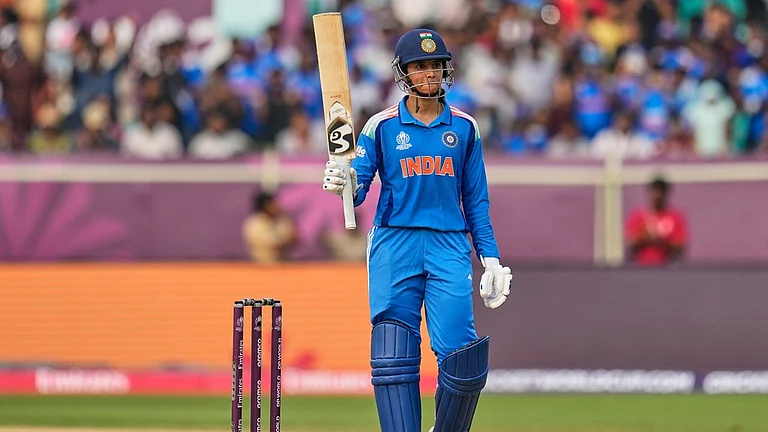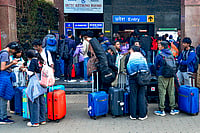The Bengali as we know, or think of, him appeared for the first time in the late 18th century, at the confluence of, principally, three cultures: the Muslim, the local Bengali and the British. What appeared on the horizon, at first, hesitantly, individual by individual, sometimes dressed in Persian-influenced clothes, like Raja Rammohun Roy, gradually emboldened into a type and extended into a species as the 19th century progressed. It’s difficult to know exactly where the Bengali first came from, because he’s less likely to be found (despite what we’re told by popular mythology) at the origin or source of things than at midstream, at the confluence of different currents, or at the junction of the arterial routes of history, wondering where to go next.
This point at midstream, this junction in history, has a grand name - the Bengal, or the Indian, renaissance. It has certain similarities with its namesake, the Italian renaissance, which occurred about 400-500 years earlier; they may be worth glancing at again. In both cases, a new secularised intelligentsia, or class, was created; in Bengal, a new bourgeoisie, the product of colonial trade, collaboration, education, and of institutions like the Hindu College, began to emerge gradually in the 19th century, and came to be called the bhadralok class. In both cases this class turned away from contemporary medievalism, or, in the instance of Bengal, feudalism, to other cultures and histories to find paradigms with which to reinterpret contemporaneity. The Italian renaissance turned to ancient Greece and Rome; the Bengali middle-class, through colonial contact, to the cultural movements of Europe and the
Anglo-Saxon world. It also used the ancient texts of the Upanishads and the Vedas to turn away from a polyphonic Hinduism and inaugurate a spiritual humanism, in the incarnation of the Brahmo Samaj, sanctioned by ‘indigenous’ scriptures, notwithstanding that many of them had been rediscovered by British orientalists. Coincidentally, two poets, and composers of sonnets, occupy pivotal interpretative roles in each renaissance; Petrarch is one of the first persons of his time to identify that he was living in an age of darkness, and to speak of the need to turn to the classical world for inspiration; Henry Louis Vivian Derozio, centuries later, would, in the early decades of the Bengal renaissance, make a similar plea in sonnets (now rarely read except by schoolchildren) like "To India - My Native Land".
The differences between the renaissances are probably equally, if not more, illuminating. The humanists of the Italian renaissance, over-attached to the idea of classical antiquity and to Latin, resisted the rise of poets like Dante and Boccaccio who sought to use the Italian vernacular. The Bengal renaissance, on the other hand, can be seen to be more or less concomitant with, and profoundly linked to, the rise of the Bengali vernacular, its increasing de-sanskritisation, its movement away from a ‘chaste’ to a more colloquial diction. There is another, more vital difference. Whatever the disagreements, say, between Pope and Emperor, the major artists and the Pope, the Italian renaissance has left behind artefacts that were commissioned by the official hegemony: for instance Michelangelo’s frescoes on the ceiling of the Sistine Chapel.The Bengal renaissance took place, in contrast, in a colonised country; its occurrence was hardly recognised by the ruling hegemony, the British coloniser. There’s, thus, a degree of concealment and reticence even about its most assertive moments. Calcutta was an imperial city, and yet its imperial buildings have little to do with the renaissance. The Bengal renaissance, unlike the Italian, has left no grand monument, no Sistine Chapel, precisely because it didn’t have imperial sanction, the sanction of the British ruling class. When I wish to acquaint friends visiting Calcutta with its history, I take them not to monuments, but to houses people have lived in, like Tagore’s Jorasanko, or to a relative’s house, or to the coffee shops in which university students gathered, or the cemeteries where people were buried.
The principal site of the renaissance - bhadralok society - was always only an equivocal and qualified hegemony, without access to absolute political power; it was created first as a professional cadre of clerks and bureaucrats, then barristers, doctors, teachers; in colonial times, it worked for the rulers, but never really became a ruling class itself. In post-Independence India, this class remained at one remove from total political power and continued to inhabit its fragile, increasingly endangered world of professional, educational success and social propriety. No wonder that this class chose as its national poet not an epic poet, as most national poets are, but a lyric poet, Tagore, a poet, in his songs and verse, of hesitancies, reticences, and elisions, a poet who approached the absolute indirectly and ambivalently.
The renaissance Bengali, always about to vanish from history into silence, has now probably ceased to exist. The last great representatives died in their houses in the final decade of the 20th century; Satyajit Ray in Calcutta, Nirad Chaudhuri, in 1998, in Oxford. Perhaps Amartya Sen is the last living representative. Is this the renaissance Bengali’s fate, to die unhappily at home, or spend his days in exile, in grand trappings, in the country of the erstwhile coloniser? Meanwhile, the educated Bengali continues to observe old obeisances and rituals: Tagore songs, watching Ray on video. Of course, the middle-class, the world over, has ceased to be the arbiter of ‘high’ culture; middle-class humanism has been replaced by post-modernity. But post-modernity still hasn’t come to Bengal; there’s no such thing as a post-modern Bengali, just as there’s no such thing as a post-modern humanist. The Bengali, or whatever we might call him now, must wait and see what happens to him. As he waits, he can only hope to map the discrepancies and slippages of meaning that’ve been his history so far.

























